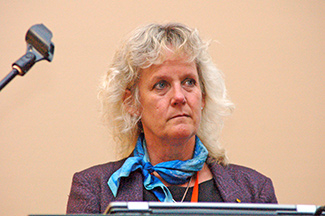Gene Editing the Polled Allele
Advances in gene editing allows for introduction of useful alleles.
by Kaci Foraker, editorial intern
BROOKINGS, S.D. (June 19, 2019) — Researchers are using beef cattle genetics to solve an animal welfare issue in dairy cattle.
Alison Van Eenennaam, extension specialist in animal biotechnology and genomics at the University of California–Davis (UCD), presented her latest work in genetic editing at the 2019 Beef Improvement Federation Symposium in Brookings, S.D., June 18-21.

strong>Alison Van Eenennaam
“Genetic variation is a breeder’s friend,” said Alison Van Eenennaam, exentension specialist in animal biotechnology and genomics at the University of California–Davis. “If you have a really big increase in inbreeding, you are basically taking away your future possibility of genetic improvement, as you are becoming less genetically diverse.” [Photo by Troy Smith]
“The overall drive of our selection programs hasn’t changed,” said Van Eenennaam. “Our breeding objectives have remained the same. We are still interested in disease-resistant animals. We are interested in productive animals and trying to go after some welfare traits, but our overall objectives haven’t changed.”
Genetic solution
Van Eenennaam’s group focused recent work on addressing the welfare issue of horned Holsteins. The presence of horns can create a dangerous environment for employees and other cattle, so young cattle must be dehorned.
To create a solution for this problem, a small company, Recombinetics of Minnesota, introduced the polled gene from Angus cattle to Holstein embryos to produce polled Holsteins. The UCD group collaborated on the phenotypic evaluation of the gene-edited cattle.
There are already Holsteins that are polled. However, Van Eenennaam stated that homozygous polled Holsteins net approximately $150 less profit compared to a horned animal. This decrease is partially due to the effects of inbreeding, but producers still don’t want to take a profit decrease, so they stay away from those genetics.
Van Eenennaam’s group tested a data model that projected requiring all Holsteins to be polled. The results of this projection showed the frequency of horned cattle would significantly decrease, but there would be a rapid growth in the occurrence of inbreeding.
“Genetic variation is a breeder’s friend,” said Van Eenennaam. “If you have a really big increase in inbreeding, you are basically taking away your future possibility of genetic improvement, as you are becoming less genetically diverse.”
To solve the negative economic impact that is seen in many polled Holsteins, Van Eenennaam predicted editing the top 1% of sire’s genes would decrease the occurrence of horns while still keeping the same possibility of future genetic gain.
At UCD, a gene-edited homozygous polled bull produced by Recombinetics was bred to horned Herefords and produced offspring without horns. This outcome was expected, as the polled gene is dominant compared to the horned allele.
Approaches
There are two main ways to edit cattle. The first is to edit a somatic cell from an elite animal and then clone that cell. To do this, DNA is first taken from a donor oocyte (egg cell). Then the diploid nucleus from the edited somatic cell is moved into the oocyte and implanted into a surrogate dam, said Van Eenennaam. Nine months later a homozygous non-mosaic edited animal will be produced.
The second approach is to introduce the edit into the developing embryo. In-vitro maturation of the ovocyte uses the DNA from the female, inseminates the egg, produces a zygote and then editing reagents are introduced into the zygote. Seven days later the developing embryo can be transferred into a surrogate dam. The offspring of this approach will most likely be a heterozygous or mosaic animal, and a homozygous animal can be developed through generations of breeding, said Van Eenennaam.
“Genome editing is like sprinkling on top dressing,” said Van Eenennaam “It’s a little bit of a cherry on top of a breeding sundae. Nothing about our traditional breeding programs is going to go away because of editing, but what it does do is offer the opportunity to introduce useful alleles into cattle breeding programs without linkage drag, and enable the precise and rapid transfer of useful genetic variants between different breeds of cattle.”
Van Eenennaam summarized:
- Gene editing offers an approach to precisely introduce useful genetic variation into food animal breeding programs.
- Gene editing is distinct from genetic engineering because it is targeted and does not necessariy involve the introduction of foreign DNA.
- It opens up new opportunities for breeders to address critical problems such as disease resistance, animal welfare and resillience, and product quality traits.
The 2019 BIF Annual Convention was hosted by South Dakota State University and the South Dakota Beef Breeds Council June 18-21 at the University Comfort Suites and Convention Center in Bookings. ANGUS MEDIA® provides comprehensive online coverage of the event at www.BIFconference.com. Visit the Newsroom for summaries, proceedings, PowerPoints, video and/or audio of the sessions and the Awards page for announcements and photos of award winners.
Editor’s Note: This summary was written under contract or by staff of ANGUS MEDIA®. Through an agreement with the Beef Improvement Federation,
we encourage reprinting of the articles to those who will adhere to the
reprint guidelines available on this site. Please review those
guidelines or contact Shauna Rose Hermel,
editor, at 816-383-5270. PowerPoints are posted with permission of the
presenter and may not be reproduced in whole or in part without the
express permission of the presenter. We welcome educational venues and
cattlemen to link to this site as a service to their audience.
For questions about this site, or to notify us of broken links, click here. Look for additional coverage in the Angus Journal, the Angus Beef Bulletin, the Angus Journal Daily, the Angus Beef Bulletin EXTRA and Angus TV.


